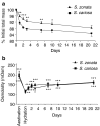Heat shock proteins and resistance to desiccation in congeneric land snails
- PMID: 19953352
- PMCID: PMC3082649
- DOI: 10.1007/s12192-009-0150-9
Heat shock proteins and resistance to desiccation in congeneric land snails
Abstract
Land snails are subject to daily and seasonal variations in temperature and in water availability and depend on a range of behavioral and physiological adaptations for coping with problems of maintaining water, ionic, and thermal balance. Heat shock proteins (HSPs) are a multigene family of proteins whose expression is induced by a variety of stress agents. We used experimental desiccation to test whether adaptation to different habitats affects HSP expression in two closely related Sphincterochila snail species, a desiccation-resistant, desert species Sphincterochila zonata, and a Mediterranean-type, desiccation-sensitive species Sphincterochila cariosa. We examined the HSP response in the foot, hepatopancreas, and kidney tissues of snails exposed to normothermic desiccation. Our findings show variations in the HSP response in both timing and magnitude between the two species. The levels of endogenous Hsp72 in S. cariosa were higher in all the examined tissues, and the induction of Hsp72, Hsp74, and Hsp90 developed earlier than in S. zonata. In contrary, the induction of sHSPs (Hsp25 and Hsp30) was more pronounced in S. zonata compared to S. cariosa. Our results suggest that land snails use HSPs as part of their survival strategy during desiccation and as important components of the aestivation mechanism in the transition from activity to dormancy. Our study underscores the distinct strategy of HSP expression in response to desiccation, namely the delayed induction of Hsp70 and Hsp90 together with enhanced induction of sHSPs in the desert-dwelling species, and suggests that evolution in harsh environments will result in selection for reduced Hsp70 expression.
Figures








Similar articles
-
Natural annual cycle of heat shock protein expression in land snails: desert versus Mediterranean species of Sphincterochila.J Exp Biol. 2010 Oct 15;213(Pt 20):3487-95. doi: 10.1242/jeb.047670. J Exp Biol. 2010. PMID: 20889829
-
The heat shock response in congeneric land snails (Sphincterochila) from different habitats.Cell Stress Chaperones. 2012 Sep;17(5):639-45. doi: 10.1007/s12192-012-0340-8. Epub 2012 Apr 26. Cell Stress Chaperones. 2012. PMID: 22535471 Free PMC article.
-
Heat shock proteins and survival strategies in congeneric land snails (Sphincterochila) from different habitats.Cell Stress Chaperones. 2012 Sep;17(5):523-7. doi: 10.1007/s12192-012-0341-7. Epub 2012 Apr 24. Cell Stress Chaperones. 2012. PMID: 22528052 Free PMC article. Review.
-
Natural variation in resistance to desiccation and heat shock protein expression in the land snail Theba pisana along a climatic gradient.Physiol Biochem Zool. 2015 Jan-Feb;88(1):66-80. doi: 10.1086/679485. Epub 2014 Dec 2. Physiol Biochem Zool. 2015. PMID: 25590594
-
Heat Shock Proteins as Immunomodulants.Molecules. 2018 Nov 1;23(11):2846. doi: 10.3390/molecules23112846. Molecules. 2018. PMID: 30388847 Free PMC article. Review.
Cited by
-
Low-temperature exposure has immediate and lasting effects on the stress tolerance, chemotaxis and proteome of entomopathogenic nematodes.Parasitology. 2023 Jan;150(1):15-28. doi: 10.1017/S0031182022001445. Epub 2022 Oct 14. Parasitology. 2023. PMID: 36328953 Free PMC article.
-
Phenotypic diversity, population structure and stress protein-based capacitoring in populations of Xeropicta derbentina, a heat-tolerant land snail species.Cell Stress Chaperones. 2014 Nov;19(6):791-800. doi: 10.1007/s12192-014-0503-x. Epub 2014 Mar 2. Cell Stress Chaperones. 2014. PMID: 24609822 Free PMC article.
-
Chaperone proteins: universal roles in surviving environmental stress.Cell Stress Chaperones. 2023 Sep;28(5):455-466. doi: 10.1007/s12192-022-01312-x. Epub 2022 Nov 28. Cell Stress Chaperones. 2023. PMID: 36441380 Free PMC article. Review.
-
Snails in the sun: Strategies of terrestrial gastropods to cope with hot and dry conditions.Ecol Evol. 2019 Sep 30;9(22):12940-12960. doi: 10.1002/ece3.5607. eCollection 2019 Nov. Ecol Evol. 2019. PMID: 31788227 Free PMC article. Review.
-
Population influences desiccation tolerance in an invasive aquatic snail, Potamopyrgus antipodarum (Tateidae, Mollusca).PeerJ. 2023 Jul 13;11:e15732. doi: 10.7717/peerj.15732. eCollection 2023. PeerJ. 2023. PMID: 37461406 Free PMC article.
References
-
- Adhikari AS, Sridhar Rao K, Rangaraj N, Parnaik VK, Mohan Rao C. Heat stress-induced localization of small heat shock proteins in mouse myoblasts: intranuclear lamin A/C speckles as target for alpha B-crystallin and Hsp25. Exp Cell Res. 2004;299:393–403. doi: 10.1016/j.yexcr.2004.05.032. - DOI - PubMed
-
- Arad Z. Desiccation and rehydration in land snails—a test for distinct set points in Theba pisana. Isr J Zool. 2001;47:41–53.
-
- Arad Z, Goldenberg S, Heller J. Comparative water economy in five species of Sphincterochila. J Zool (Lond) 1989;218:353–364. doi: 10.1111/j.1469-7998.1989.tb02549.x. - DOI
-
- Arad Z, Goldenberg S, Heller J. Intraspecific variation in resistance to desiccation and climatic gradients in the distribution of the land snail Xeropicta vestalis. J Zool (Lond) 1992;226:643–656. doi: 10.1111/j.1469-7998.1992.tb07507.x. - DOI
Publication types
MeSH terms
Substances
LinkOut - more resources
Full Text Sources
Research Materials

